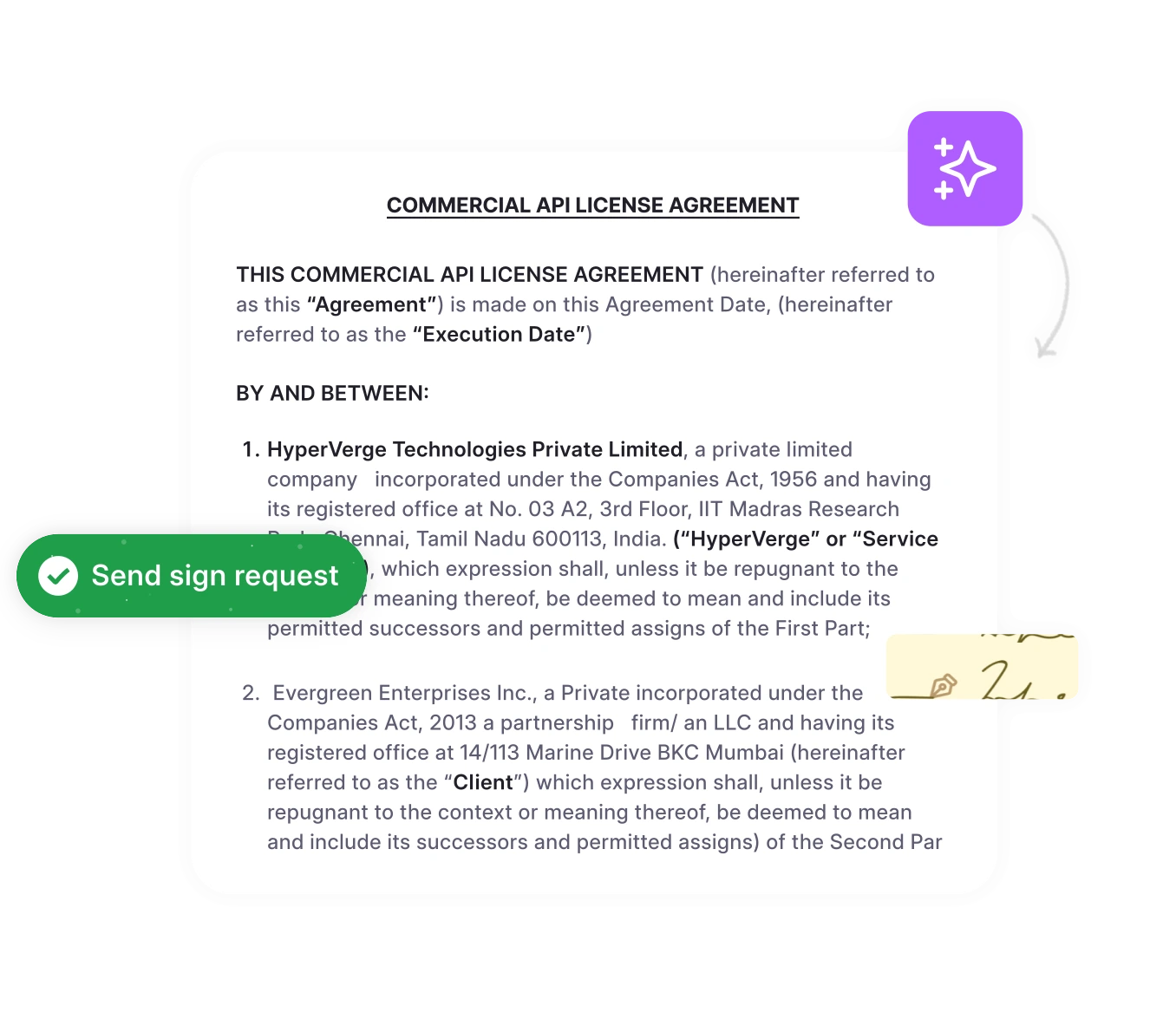Business teams often encounter contracts filled with complex legal terminology, lengthy clauses, and unclear obligations. This complexity creates friction in deal execution, as non-legal stakeholders struggle to identify key terms, assess risks, and move agreements forward efficiently. The result: delayed approvals, missed opportunities, and frustration across departments that need contract clarity to make informed decisions during business dealings.
With simple contracts, businesses can cut through ambiguity and accelerate approvals while maintaining full legal protection.
When combined with effective contract management strategies, this streamlined approach helps teams close deals faster, avoid costly delays, and focus resources on strategic growth rather than administrative tasks.
In this blog, we take you through what simple contracts are, key elements, how to create one, and the role of CLM to avoid any breaches.
What is a simple contract?
A simple contract is a legally enforceable agreement that can be created orally, in writing, or through the conduct of two or more parties involved. When compared to formal contracts that require specific procedures, simple contracts derive their validity from meeting four essential elements: offer, acceptance, consideration, and mutual intention to create legal relations.
The key characteristic that distinguishes simple contracts is their accessibility. They don’t require:
- Witnesses to observe the signing
- Official seals or stamps
- Notarization or formal documentation
- Complex legal procedures or formalities
Instead, simple contracts focus on clarity and mutual understanding. From a business perspective, simple contracts enable faster decision-making and reduced administrative overhead.
Legal teams can process them quickly, sales teams can close deals without lengthy approval cycles, and operational teams can establish vendor relationships efficiently.
Understanding what a simple contract is, it’s important to understand the key elements that constitute such contracts, as these elements determine their validity and enforceability.
What are the key elements of simple contracts?
A simple contract relies on a few fundamental elements to be considered valid and enforceable. Here is a list of 4 essential elements that form the backbone of simple contracts as below:
1. Offer
One party must make a clear, definite proposal to another party. The offer must be specific enough that acceptance creates certainty about the terms. “We’ll provide marketing services for your Q1 campaign” is too vague, while “We’ll provide social media management for your Q1 campaign, including 20 posts per month and weekly analytics reports, for $3,000” creates a valid offer.
2. Acceptance
The other party must agree to the exact terms of the offer. Acceptance can be expressed through words, actions, or conduct. Importantly, any change to the original terms constitutes a counteroffer rather than acceptance. Understanding these nuances is crucial for effective contract negotiations.
3. Consideration
Both parties must exchange something of value. This doesn’t need to be money—services, goods, promises, or even nominal amounts satisfy the consideration requirement. The law generally doesn’t evaluate whether the consideration is adequate, only that it exists.
4. Intention to create legal relations
Two parties or more must intend for the legal agreement to be binding. Business agreements typically carry this presumption, while social or family arrangements often don’t. Clear language about legal rights, commitments, and consequences helps establish this intention.
| Review simple contracts accurately with AI HyperStart identifies deviant language, missing clauses, and risk-heavy terms—so even straightforward agreements are signed with confidence. Book a Demo |
With a clear understanding of the key elements that make up a simple contract, we can now turn our attention to the process of creating these contracts in practice.
How to create simple contracts?
Crafting a simple contract means striking the right balance between legal protection and practical business needs.
Let’s look at 6 essential steps to create agreements that safeguard your interests while staying clear, efficient, and easy to put into action.
Step 1: Define the core transaction
Start by clearly identifying what each party is providing and receiving. This forms the foundation of your contract and should be specific enough to prevent misunderstandings. You can also use modern contract creation tools can help streamline this process significantly.
Essential questions to address:
- What specific goods or services are being provided?
- What is the exact compensation or exchange?
- When must the performance be completed?
- Where will the work be performed or delivered?
- Who has responsibility for various aspects of the transaction?
Example approach: Instead of “Company will provide marketing services,” specify “Company will create and manage social media campaigns on Facebook, Instagram, and LinkedIn, including 15 posts per month and weekly performance reports.”
Step 2: Establish clear terms and conditions
Simple contracts should address the most important terms without overwhelming detail. Focus on elements that commonly cause disputes or confusion.
Key terms to include:
- Payment details: Amount, schedule, method, and late payment consequences
- Performance standards: Quality expectations, delivery requirements, acceptance criteria
- Timeline specifics: Start dates, milestones, completion deadlines, and extension procedures
- Basic responsibilities: Who provides what, when, and to what standard
- Modification procedures: How changes will be handled and approved
Step 3: Include essential legal protections
Even simple contracts need basic legal safeguards. Include only the protections most relevant to your specific transaction type. Consider implementing a contract review checklist to ensure nothing important is missed.
Common protections:
- Provisions for confidential information: Protect sensitive information shared during the relationship
- Intellectual property clauses: Clarify ownership of work products and existing IP
- Termination conditions: Define how either party can end the agreement
- Limitation of liability: Set reasonable boundaries on potential damages
- Governing law: Specify which jurisdiction’s laws apply
Step 4: Use clear, professional language
Write contracts in plain English that all parties can understand. Avoid legal jargon unless it’s necessary for precision. When complex terms are required, include brief explanations. This approach aligns with modern contract drafting best practices.
Writing best practices:
- Use active voice: “Company will deliver” instead of “Delivery will be made by Company”
- Define important terms: If you use “deliverables,” explain what they include
- Keep sentences concise: Aim for one concept per sentence
- Use consistent terminology: Don’t call the same thing by different names
Step 5: Review and finalize
Before signing, ensure the contract accurately reflects your understanding and includes all essential elements.
Final review checklist:
- All parties are correctly identified with their proper legal names
- Deliverables and expectations are clearly specified
- Payment terms and amounts are accurate
- Dates and deadlines are realistic and properly calculated
- Contact information and communication procedures are included
- Signature lines and dates are present for all parties
Step 6: Implement proper execution
Simple contracts still require proper execution to be enforceable in court.
Execution best practices:
- Ensure all parties sign the same document version
- Include signature dates to establish the agreement timeline
- Provide copies to all parties immediately after signing
- Store the executed contract in an accessible location
- Set up tracking for important dates and obligations
Technology advantage: Modern contract management platforms can automate much of this process, generating simple contracts from templates, routing them for electronic signature, and automatically tracking key dates and obligations.
Once we have covered the process of creating simple contracts, it is important to recognize the different main types of these contracts that are commonly used.
What are the main types of simple contracts?
Simple contracts span virtually every industry and business function. Understanding common types helps identify opportunities to streamline your own contract processes while maintaining appropriate legal protection.
| Contract Type | Common Use Cases | Typical Terms | Business Benefits |
| Service Agreements | Freelance work, consulting, and professional services | Deliverables, timeline, payment schedule, scope of work | Quick vendor onboarding, clear expectations, and minimal negotiation |
| Employment Contracts | Job offers, contractor agreements, NDAs | Position, salary, start date, confidentiality terms | Faster hiring, standardized terms, and legal protection |
| Sales Agreements | Product sales, equipment purchases, software licenses | Item description, price, delivery terms, payment method | Rapid deal closure, clear transfer of ownership |
| Vendor/Supplier Contracts | Purchase orders, construction, maintenance, supply contracts | Quantities, pricing, delivery schedule, service levels | Streamlined procurement, predictable costs |
| Real Estate Agreements | Lease or rental agreement, property management, and facility agreements | Rent amount, duration, responsibilities, and maintenance terms | Quick occupancy, clear obligations |
| Partnership Agreements | Joint ventures, referral programs, and collaboration deals | Contributions, profit sharing, responsibilities, duration | Fast partnership setup, defined roles |
| Technology Contracts | Website development, digital marketing, IT services | Project scope, deliverables, timeline, performance metrics | Agile project execution, measurable outcomes |
With a clear grasp of the various main types of simple contracts, it becomes essential to consult an attorney to examine the potential consequences and legal remedies that arise when these contracts are breached.
What happens when a simple contract is breached?
When a simple contract is breached, it means one party has failed to fulfill their agreed-upon obligations, which can lead to various legal consequences and remedies to address the harm caused.
1. Material breach
A material breach occurs when one party fails to perform a significant obligation that defeats the contract’s essential purpose. For example, if a web developer fails to deliver a completed website by the agreed deadline, preventing the client from launching their business as planned.
Consequences: The non-breaching party can terminate the contract, refuse further performance, and seek damages for losses caused by the breach.
2. Minor breach
A minor breach involves failure to perform some aspect of the contract without substantially frustrating its purpose. For instance, a service provider completes work on time but uses slightly different materials than specified, without affecting functionality.
Consequences: The contract continues, but the non-breaching party can seek compensation for any additional costs or reduced value.
3. Anticipatory breach
This occurs when one party clearly indicates they won’t fulfill their obligations before performance is due. A contractor stating they can’t complete work by the deadline due to resource constraints creates an anticipatory breach.Consequences: The non-breaching party can immediately treat the contract as breached and seek alternative arrangements.
Preventing these issues requires robust contract compliance processes and regular monitoring. For businesses dealing with multiple contracts, implementing a contract compliance audit system can help identify potential problems.
When things go wrong with a simple agreement, having a good system like Contract Lifecycle Management can make all the difference in keeping everything on track.
How does CLM help manage simple contracts?
Contract Lifecycle Management (CLM) platforms turn simple contracts into strategic business assets through automation, visibility, and proactive risk management.
1. Automated contract creation and workflows
CLM platforms store pre-approved templates and auto-fill details like parties, pricing, and timelines. Automated approval workflows route contracts to the right stakeholders based on value or risk, reducing errors and enabling faster execution.
2. Comprehensive lifecycle tracking
Systems track obligations—payments, deliveries, and renewals—while sending alerts to prevent missed deadlines. Automated contract renewal and amendment workflows minimize disputes and maintain strong business relationships.
3. Analytics and intelligence
CLM tools analyze performance data to highlight successful terms, potential risks, and areas for optimization. AI-driven platforms like HyperStart learn from past contracts to suggest better terms and improve compliance continuously.
4. Seamless team and system integration
Integration with CRM, ERP, and project tools keeps sales, finance, and operations aligned. Real-time visibility into status and obligations removes silos and supports smooth cross-functional collaboration.
Transform your simple contract management with HyperStart
Simple contracts that are strategically managed serve as business accelerators. They provide the legal framework necessary for growth while enabling teams to execute deals efficiently.Where manual contract processes often fail to scale with business complexity—Modern CLM platforms address these operational challenges through automated workflows, centralized repositories, and AI-assisted review capabilities. See how HyperStart does it.











